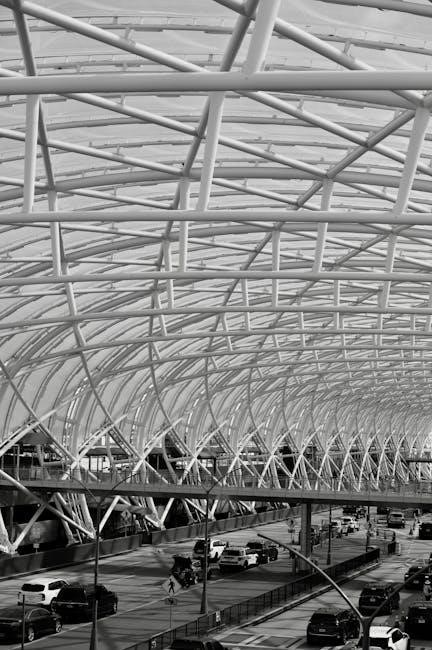A flat roof construction details PDF provides essential insights into designing and building durable‚ weather-tight roofs. It covers materials‚ structural elements‚ and best practices for installation and maintenance.
1.1 Overview of Flat Roofs
A flat roof is a horizontal or nearly horizontal roof structure commonly used in commercial and residential buildings. Unlike pitched roofs‚ flat roofs provide a sleek‚ modern appearance and maximize interior space. They are constructed using various materials‚ with timber being the most common in residential settings. Flat roofs serve as a barrier against weather elements and play a crucial role in reducing heat loss. They are categorized into warm‚ cold‚ and inverted designs‚ each with unique construction details. Proper design and installation ensure durability‚ while details like edges‚ junctions‚ and drainage are critical for performance. Resources like flat roof construction details PDFs offer comprehensive guides for architects and builders.

1.2 Importance of Flat Roof Construction Details
Flat roof construction details are crucial for ensuring durability‚ weather-tightness‚ and structural integrity. Proper detailing addresses critical areas like edges‚ junctions‚ and penetrations‚ preventing leaks and structural damage. It ensures compliance with building codes and enhances thermal performance. Detailed plans guide contractors‚ reducing errors and ensuring materials are used effectively. Without accurate details‚ roofs may fail prematurely‚ leading to costly repairs. A well-documented flat roof construction details PDF provides clear instructions‚ benefiting architects‚ builders‚ and homeowners. It simplifies the design and installation process‚ ensuring a reliable and long-lasting roofing system. Attention to detail is essential for achieving a safe and efficient flat roof construction.

Types of Flat Roofs
Flat roofs are categorized into warm‚ cold‚ and inverted constructions. Each type varies in insulation placement and structural design‚ ensuring suitability for different building requirements and climates.
2.1 Warm Roof Construction
A warm roof construction involves placing the insulation above the roof deck‚ ensuring the structural deck remains within the thermal envelope. This design minimizes heat loss‚ improves energy efficiency‚ and reduces condensation risks. The waterproofing membrane is installed on top of the insulation‚ protecting the structure from weather elements. Warm roofs are ideal for modern buildings‚ offering a continuous thermal layer and reducing thermal bridging. They are commonly used in commercial and residential projects‚ providing durable and weather-tight solutions. Proper detailing‚ such as at edges and junctions‚ is crucial for long-term performance. This method is favored for its ability to meet stringent thermal performance requirements.

2.2 Cold Roof Construction
A cold roof construction involves placing insulation below the roof deck‚ typically above the ceiling. This design is common in regions with heavy rainfall and requires careful waterproofing. The structure includes a vapor barrier to prevent moisture buildup‚ ensuring the insulation remains dry. Cold roofs are often less expensive than warm roofs but may face challenges with condensation. Proper ventilation is crucial to maintain structural integrity. Materials like wood or concrete are used for the deck‚ and drainage systems must be efficient to handle water accumulation. Regular inspections are recommended to address potential leaks or insulation issues early. This method is ideal for buildings with specific climate needs.
2.3 Inverted Roof Construction
An inverted roof construction places insulation above the waterproofing membrane‚ unlike traditional designs. This method protects the membrane from weathering and mechanical damage‚ enhancing durability. A protective layer‚ such as concrete or gravel‚ is added on top of the insulation. This design is ideal for flat roofs in high-traffic areas or extreme climates. Proper drainage is critical to prevent water pooling‚ which can lead to structural issues. Inverted roofs offer improved thermal performance and fire resistance‚ making them a popular choice for modern buildings. Detailed section drawings in a flat roof construction details PDF provide precise installation guidelines for this unique design.

Materials and Components
Flat roof construction details PDFs outline essential materials‚ including decking‚ insulation types‚ waterproofing membranes‚ and structural elements‚ ensuring durability and weather-tight performance.

3.1 Decking Materials
Decking materials form the structural base of a flat roof‚ ensuring stability and durability. Common options include concrete‚ timber‚ and metal. Concrete is durable and fire-resistant but heavy‚ requiring robust structural support. Timber‚ often used in residential projects‚ is cost-effective but needs treatment to resist rot and pests. Metal decking is lightweight‚ corrosion-resistant‚ and ideal for modern designs. Each material has specific installation requirements and must align with the roof’s intended use and load-bearing capacity. Proper selection ensures a solid foundation for insulation‚ waterproofing‚ and other components‚ making it critical for long-term performance and safety.
- Concrete: High strength‚ fire-resistant‚ but heavy.
- Timber: Cost-effective‚ lightweight‚ but requires treatment;
- Metal: Durable‚ lightweight‚ and versatile.
Choosing the right decking material is essential for a flat roof’s structural integrity and longevity.
3.2 Insulation Types
Insulation is crucial for energy efficiency and thermal performance in flat roofs. Common types include rigid insulation boards (e.g.‚ PIR‚ EPS‚ and XPS) and fibrous insulation (e.g.‚ mineral wool). Rigid boards are durable and provide high thermal resistance‚ making them ideal for warm and inverted roof constructions. Fibrous insulation is often used in cold roofs‚ offering flexibility and cost-effectiveness. Each type has specific thermal conductivity values‚ ensuring optimal performance based on climate and design requirements. Proper insulation selection minimizes heat loss‚ reduces energy costs‚ and enhances the roof’s overall durability. It is essential to consider factors like moisture resistance and compatibility with other roofing components when choosing insulation.
- Rigid Insulation Boards: High thermal resistance and durability.
- Fibrous Insulation: Flexible and cost-effective for cold roofs.
Insulation plays a vital role in achieving energy efficiency and structural integrity in flat roof systems.
3.3 Waterproofing Membranes
Waterproofing membranes are a critical component in flat roof construction‚ ensuring protection against water infiltration and weathering. Common types include EPDM (rubber)‚ PVC (polyvinyl chloride)‚ and bituminous membranes. EPDM is known for its durability and resistance to UV light‚ while PVC offers superior chemical resistance. Bituminous membranes are cost-effective and provide excellent waterproofing properties. These membranes are typically applied over insulation and decking‚ ensuring a watertight seal. Proper installation and material selection are vital to prevent leaks and extend the roof’s lifespan. Detailed specifications and application methods are often outlined in flat roof construction details PDFs‚ guiding contractors for flawless execution.
- EPDM: Durable and UV-resistant.
- PVC: Chemically resistant and flexible.
- Bituminous: Cost-effective and reliable.
Waterproofing membranes are essential for maintaining the integrity and longevity of flat roof systems.
3.4 Structural Elements
Structural elements in flat roof construction are essential for supporting the roof’s weight and external loads; These include beams‚ joists‚ and decking‚ which distribute weight evenly. Steel and concrete are common materials due to their strength and durability. Timber is also used‚ offering a cost-effective solution. Proper design ensures the roof can handle static and dynamic loads‚ including foot traffic and equipment. Load calculations are critical to avoid structural failure. Connections and supports must be robust to maintain integrity. Detailed drawings in flat roof construction details PDFs provide precise specifications for these elements‚ ensuring safety and stability. Regular inspections are recommended to maintain structural health.
- Beams and Joists: Provide structural support.
- Decking: Acts as the base layer.
- Load Calculations: Ensure weight distribution.
Structural elements are the backbone of a flat roof system‚ requiring careful planning and execution.
Design Considerations
Design considerations are crucial for flat roof functionality and durability. Key factors include load calculations‚ drainage systems‚ thermal performance‚ and fire resistance to ensure structural integrity and safety.
4.1 Load Calculations
Load calculations are critical in flat roof construction to ensure structural integrity. They involve determining the weight the roof must support‚ including materials‚ insulation‚ and external forces like snow and wind. Dead loads (permanent structures) and live loads (temporary weights) must be accurately assessed. Factors like material density‚ span‚ and local building codes influence these calculations. Proper load distribution ensures the roof withstands stresses without deformation. Incorrect calculations can lead to structural failure‚ making precise computations essential for safety and durability. Engineers use specialized software and manual methods to verify load-bearing capacities‚ ensuring the roof meets design specifications and regulatory requirements.
4.2 Drainage Systems
Effective drainage systems are critical for flat roofs to prevent water pooling‚ which can lead to leaks and structural damage. A well-designed system ensures water flows efficiently off the roof. Internal and external drainage systems are common‚ with gutters‚ downspouts‚ and scuppers being key components. Proper slope design and placement of drainage outlets are essential to avoid water accumulation. Regular maintenance‚ such as clearing debris from gutters‚ is vital to ensure system functionality. Designers must consider roof pitch‚ material compatibility‚ and local rainfall patterns when selecting drainage solutions. Compliance with building codes and standards is also necessary for safety and durability.
4.3 Thermal Performance
Thermal performance is critical in flat roof construction‚ ensuring energy efficiency and comfort. Proper insulation‚ such as rigid boards or fibrous quilts‚ minimizes heat loss and reduces energy consumption. Materials like foam boards or mineral wool are commonly used‚ offering high thermal resistance. Warm‚ cold‚ and inverted roof designs each have unique thermal considerations. For instance‚ warm roofs place insulation above the deck‚ while inverted roofs position it above the waterproofing membrane; Ensuring continuity of insulation at junctions and edges is vital to prevent thermal bridging. Regular maintenance and professional inspections help sustain optimal thermal performance‚ making flat roofs environmentally friendly and cost-effective.
4.4 Fire Resistance
Fire resistance is a critical aspect of flat roof construction‚ ensuring safety and compliance with building codes. Materials like rigid insulation boards and waterproofing membranes must meet fire rating standards to prevent ignition and spread. Design details‚ such as proper insulation placement and membrane thickness‚ play a key role in achieving fire resistance. Regular inspections and adherence to fire safety regulations are essential to maintain integrity. Additionally‚ structural elements should be designed to withstand fire-related stresses‚ ensuring the roof remains stable during emergencies. Proper detailing at junctions and penetrations further enhances fire performance‚ safeguarding the building and its occupants from potential hazards.
Construction Process
The flat roof construction process involves site preparation‚ insulation installation‚ waterproofing application‚ and finishing touches‚ ensuring a durable and weather-tight structure.
5.1 Site Preparation
Site preparation is the foundation of successful flat roof construction; It involves clearing the area‚ ensuring the surface is level‚ and removing debris. Proper drainage and structural integrity must be verified. Inspect for obstructions like vegetation or uneven ground. Mark the perimeter and align it with architectural plans. Ensure all materials are stored safely and within easy access. Conduct safety checks to prevent accidents. Verify measurements and layouts before proceeding. A well-prepared site ensures smooth installation and minimizes delays. Attention to detail in this phase is critical for achieving a durable and weather-tight flat roof system.

5.2 Insulation Installation
Insulation installation is a critical step in flat roof construction‚ ensuring energy efficiency and thermal performance. Rigid boards are typically placed above the deck‚ while fibrous quilts are installed above the ceiling. Proper alignment and securing of insulation materials are essential to prevent gaps and ensure even distribution of weight; Adhering to manufacturer guidelines is vital for optimal performance. Regular inspections during installation help identify and address issues early‚ minimizing the risk of future problems. Detailed diagrams in a flat roof construction details PDF provide clear guidance for achieving a well-insulated and durable roof system.
5.3 Waterproofing Application
Waterproofing is a critical step in flat roof construction‚ ensuring long-term durability and protection against leaks. The application involves installing a waterproofing membrane‚ which can be made of materials like EPDM‚ PVC‚ or bituminous compounds. Proper surface preparation is essential‚ including cleaning and priming the roof deck to ensure optimal adhesion. The membrane is typically applied in layers‚ with seams carefully sealed to prevent water infiltration. Post-application‚ inspections and tests are conducted to verify the membrane’s integrity. Regular maintenance‚ as outlined in construction details PDFs‚ helps extend the lifespan of the waterproofing system‚ ensuring the roof remains watertight and functional for years.
5.4 Finishing Touches
The final stage of flat roof construction involves adding the finishing touches to ensure durability and functionality. This includes installing access points like roof hatches and ladders‚ applying protective coatings‚ and adding drainage systems. Proper sealing of edges and joints is crucial to prevent leaks. Additionally‚ walkways and safety railings may be installed for maintenance access. Inspections are conducted to ensure all components are securely fastened and aligned. These details enhance the roof’s performance‚ safety‚ and aesthetic appeal‚ completing the construction process effectively.
Common Challenges and Solutions
Common flat roof challenges include leaks‚ insulation issues‚ and structural damage. Solutions involve regular inspections‚ proper insulation installation‚ and maintaining effective drainage systems.
6.1 Dealing with Leaks
Leaks in flat roofs can lead to significant structural damage if left unaddressed. Identifying the source is crucial‚ often found at seams‚ flashing‚ or drainage points. Regular inspections and maintenance are key to preventing water ingress. Repairing leaks involves sealing gaps with compatible materials and ensuring the waterproofing membrane is intact. Proper drainage systems and slope design play a vital role in preventing water pooling‚ which can exacerbate leaks. Referencing a flat roof construction details PDF can provide specific repair techniques and materials for various scenarios‚ ensuring long-term durability and weather-tight performance. Addressing leaks promptly is essential to maintain the roof’s integrity and functionality.
6.2 Insulation Issues
Insulation issues in flat roofs can lead to energy loss‚ moisture buildup‚ and structural damage; Common problems include inadequate insulation thickness‚ gaps between panels‚ and water infiltration; Mold growth and condensation can occur if insulation is improperly installed or damaged. Regular inspections are crucial to identify and address these issues early. Solutions include ensuring proper fitting of insulation materials‚ sealing gaps‚ and using vapor barriers. Upgrading to high-performance insulation types‚ like rigid foam boards‚ can enhance thermal performance and prevent future issues. Addressing insulation problems promptly helps maintain the roof’s integrity and energy efficiency‚ ensuring long-term durability and safety.
6.3 Structural Damage
Structural damage to flat roofs can occur due to poor design‚ inadequate materials‚ or external factors like heavy loads or extreme weather. Causes include insufficient support‚ material degradation‚ or improper installation. Solutions involve reinforcing the structure‚ replacing damaged components‚ and ensuring compliance with building codes. Regular inspections and maintenance are crucial to identify and address issues early. Repairing structural damage promptly prevents further deterioration and ensures the roof’s integrity. Using high-quality materials and adhering to construction best practices minimizes the risk of structural problems. Proper drainage and load distribution are also essential to avoid compromising the roof’s stability over time.

Best Practices
Regular maintenance‚ professional inspections‚ and adhering to building codes ensure longevity and performance of flat roofs‚ preventing issues like leaks and structural damage.
7.1 Regular Maintenance
Regular maintenance is crucial for extending the lifespan of a flat roof. Inspections should be conducted at least twice a year to identify and address issues early. Cleaning debris from drains and gutters ensures proper water flow‚ preventing ponding. Checking for cracks‚ blisters‚ or gaps in the waterproofing membrane is essential. Seals around vents‚ skylights‚ and other penetrations should be inspected for integrity. Addressing leaks promptly prevents structural damage. Additionally‚ trimming nearby trees and removing accumulated debris helps maintain the roof’s integrity. A well-maintained flat roof ensures long-term durability and performance‚ avoiding costly repairs. Regular upkeep is a proactive approach to safeguarding the structure.
7.2 Professional Inspections
Professional inspections are crucial for ensuring the integrity and longevity of flat roofs. Regular checks by certified experts help identify potential issues before they escalate‚ such as leaks‚ insulation gaps‚ or structural weaknesses. Inspectors evaluate the condition of waterproofing membranes‚ drainage systems‚ and insulation‚ ensuring compliance with construction details outlined in flat roof construction PDFs. They also assess junctions‚ edges‚ and penetrations for proper sealing and alignment with design specifications. Detailed reports from these inspections guide necessary repairs and maintenance‚ preventing costly damages. Utilizing resources like flat roof construction details PDFs ensures inspections are thorough and aligned with industry standards‚ safeguarding the roof’s performance over time.
7.3 Adhering to Codes
Adhering to local building codes and regulations is crucial for ensuring the safety and durability of flat roof constructions. Codes provide guidelines for materials‚ structural integrity‚ and fire resistance‚ ensuring compliance with industry standards. Proper documentation‚ such as a flat roof construction details PDF‚ helps verify adherence to these codes. Resources like Trimo Group and Sara Construction offer detailed blueprints and diagrams that align with regulatory requirements. Regular inspections and professional certifications further ensure compliance. By following codes‚ builders can avoid legal issues and guarantee a structurally sound and safe flat roof system. Always refer to updated codes and expert resources for accurate implementation.

Access Points and Safety
Access points and safety measures are crucial for flat roof construction‚ ensuring secure entry and fall protection during maintenance and inspections. Key components include roof hatches‚ ladders‚ and staircases.
8.1 Roof Hatches
Roof hatches are essential access points in flat roof construction‚ providing safe entry for maintenance‚ inspections‚ and emergencies. They are typically installed in strategic locations to ensure easy access to roof spaces‚ HVAC systems‚ and other equipment. A flat roof construction details PDF often includes specifications for hatch sizing‚ materials‚ and installation to maintain structural integrity and weatherproofing. Common materials include steel‚ aluminum‚ or fiberglass‚ with options for manual or automatic opening mechanisms. Proper sealing and insulation around hatches are critical to prevent leaks and heat loss‚ ensuring the roof remains durable and functional over time.
8.2 Ladders and Staircases
Ladders and staircases are critical for safe access to flat roofs‚ ensuring ease of maintenance and inspections. Fixed ladders or permanent staircases are often installed for regular access‚ while portable ladders may be used for occasional needs. These structures must be designed to withstand harsh weather conditions and heavy use. Materials like steel or aluminum are commonly chosen for their durability. Proper installation and anchoring are essential to prevent accidents. Regular inspections should be conducted to ensure ladders and staircases remain secure and functional. Compliance with local building codes and safety standards is mandatory to guarantee reliability and user safety over time.
8.3 Fall Protection Systems
Fall protection systems are critical for ensuring safety during flat roof construction and maintenance. These systems include guardrails‚ safety nets‚ and personal fall arrest equipment like harnesses. Guardrails are installed around roof edges to prevent falls‚ while safety nets provide a barrier below the roof. Personal fall arrest systems involve anchorage points and ropes that stop falls if someone loses balance. Compliance with local safety standards is essential. Regular inspections of these systems are necessary to maintain their effectiveness. Proper training for workers on using fall protection equipment is also vital to minimize risks and ensure a safe working environment on flat roofs.
Detailing and Drawings
Flat roof construction details PDFs include section drawings and junction details‚ ensuring clarity in design and installation. Interactive PDFs allow customization without CAD software for precise project planning.
9.1 Section Drawings
Section drawings are critical for understanding flat roof construction details. They provide a detailed cross-sectional view of the roof’s structure‚ including insulation‚ waterproofing membranes‚ and decking. These drawings highlight how different components interact‚ ensuring proper installation and weather-tightness. They often include annotations for materials‚ thicknesses‚ and junction details‚ making them invaluable for architects and contractors. By examining section drawings‚ professionals can identify potential issues like thermal bridges or drainage problems. These visual aids are essential for ensuring compliance with building codes and achieving a durable‚ energy-efficient flat roof system. They are frequently included in flat roof construction details PDFs for easy reference during planning and execution.
9.2 Junction Details
Junction details in flat roof construction are critical to ensure weather-tightness and structural integrity. These details include connections between the roof and walls‚ edges‚ and penetrations. Proper sealing at these points prevents leaks and damage. Edges must be securely fastened‚ while walls and penetrations require specialized flashing. Drainage systems at junctions are also essential to direct water away effectively. A flat roof construction details PDF often includes diagrams and specifications for these elements‚ ensuring accurate installation. These details are vital for maintaining the roof’s performance and longevity‚ addressing potential weak points that could lead to structural or water-related issues over time.

Creating a Flat Roof Construction PDF
A flat roof construction details PDF offers interactive drawings and expert tips‚ enabling professionals to create precise project-specific plans without CAD software‚ ensuring flawless installations.
10.1 Interactive Details
Interactive details in a flat roof construction details PDF allow users to create and edit project-specific drawings without CAD software. These PDF files provide customizable templates for various roof components‚ enabling architects and contractors to tailor designs to specific needs. They often include layers for insulation‚ waterproofing‚ and structural elements‚ making it easier to visualize and adjust designs. Downloadable resources from trusted sources like Trimo Group or Isopan offer comprehensive libraries of .dwg and .pdf files. These interactive tools enhance collaboration and precision‚ ensuring that construction documents are accurate and meet project requirements. They are invaluable for streamlining the design and planning process.
10.2 Downloading Resources
Downloading resources for flat roof construction details is straightforward‚ with many websites offering free PDF guides. These resources include detailed section drawings‚ junction details‚ and installation recommendations. Official websites like Trimo Group and Sara Construction provide comprehensive blueprints and expert tips. Interactive PDFs allow users to edit project-specific drawings without CAD software. Additionally‚ platforms like isopan.com offer downloadable .dwg and .pdf files for various flat roof components. These resources are invaluable for architects‚ builders‚ and homeowners‚ ensuring accurate and efficient flat roof construction. They cover materials‚ structural considerations‚ and best practices‚ making them essential for successful project planning and execution.
In conclusion‚ flat roof construction details are crucial for ensuring durability‚ weather-tightness‚ and energy efficiency. Proper design‚ material selection‚ and installation practices are essential to avoid common issues like leaks and structural damage. Regular maintenance and professional inspections play a vital role in extending the lifespan of flat roofs. By adhering to construction codes and best practices‚ builders and homeowners can achieve reliable and long-lasting roofing solutions. The availability of detailed PDF guides and resources simplifies the process‚ offering comprehensive insights for successful flat roof projects. These resources are invaluable for architects‚ contractors‚ and property owners seeking to construct or renovate flat roofs effectively.